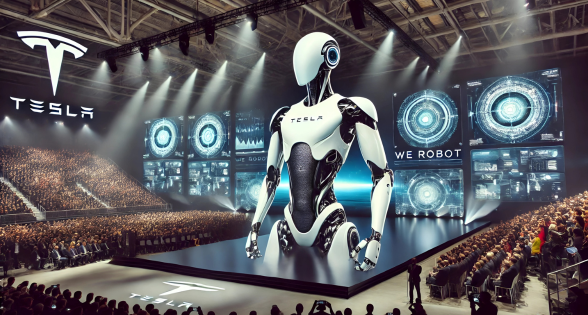Tesla recently showed off its new humanoid robot, Optimus, at the ‘We Robot’ event. This exciting reveal was a big step for Tesla in the field of robotics, attracting attention from tech fans and industry experts. The Tesla humanoid robot, or Optimus, aims to make everyday tasks easier for both home and work. This event highlights Tesla’s big plans for the future of robots, combining advanced technology with practical uses.
Tesla’s Vision for the Humanoid Robot
The Tesla humanoid robot represents Tesla’s dream to build smart robots that can work with people. With this robot, Tesla wants to simplify daily life, help with simple tasks, and even boost productivity at work. At its core, the humanoid robot focuses on being useful and easy to use. Whether helping with household chores, working in factories, or assisting healthcare workers, Tesla’s vision for its robot is broad and bold.
Elon Musk, CEO of Tesla, explained that Optimus will do more than repeat tasks. It will adapt to different settings and be versatile. Tesla is setting new standards by combining artificial intelligence, robotics, and machine learning into one powerful machine. In short, the humanoid robot is meant to make life easier and free up time for people to focus on more meaningful activities.
Key Features of the Tesla Humanoid Robot
The Tesla humanoid robot has impressive features that make it capable of many tasks. It’s designed to be agile and move like a person, thanks to Tesla’s advanced engineering. Here are some key features that make Optimus stand out:
- Human-Like Movement: Optimus moves like a human. Its arms, legs, and fingers move smoothly, so it can do many of the same tasks humans do every day.
- Advanced Sensors and AI: The robot has a network of sensors, cameras, and artificial intelligence that help it understand its surroundings. This allows it to move safely, recognize objects, and interact with people.
- Weight and Load Capacity: The robot can carry up to 20 pounds, making it suitable for physical tasks. Tesla envisions it helping with warehouse work, delivery tasks, and more.
- Safety: Tesla made safety a priority in the robot’s design. Its AI monitors all its actions to reduce errors and make it safe to operate near humans.
The Tesla humanoid robot is a remarkable piece of technology that handles tasks with ease. Its flexible design makes it perfect for many areas, including healthcare, logistics, and hospitality.
What Sets the Humanoid Robot Apart?
- One thing that sets the Tesla humanoid robot apart is how well it works with Tesla’s other technologies. Optimus is built to fit into Tesla’s software systems, which means it can interact easily with other Tesla devices and programs, including ChatGPT like interfaces for communication and task management. Tesla’s approach blends hardware and software to boost productivity and convenience, allowing users to interact with the robot more intuitively and conversationally.
- Unlike other robots, the humanoid robot learns and improves over time. It uses machine learning to adapt, remember tasks, and evolve based on feedback. This ability to improve is essential because it helps the robot get better and more efficient.
- Tesla has also worked to make this robot practical and affordable. The company plans to mass-produce it, making the Tesla humanoid robot available to more people. With cloud based software updates and remote capabilities, Tesla can continuously improve Optimus’s functionality. Once it’s widely available, Optimus could cut labor costs and increase productivity in many industries.
The Future of Robotics with Tesla’s Humanoid Robot
The Tesla humanoid robot is a glimpse into a future where robotics are a regular part of our lives. Tesla’s advancements in AI, automation, and robotics put it at the forefront of this shift. As more industries adopt robots like Optimus, we can expect to see changes in the way we work, live, and interact with technology.
Tesla has big plans for the humanoid robot, with future updates set to make it even smarter and more capable. Similar to how Alexa transformed home assistance, Tesla envisions Optimus handling a broad range of tasks from everyday chores like cleaning and organizing to more complex roles in healthcare and logistics. By continuously adding new features, Tesla aims to make Optimus an essential companion in both personal and professional spaces.
As the Tesla humanoid robot continues to evolve, it may also play a role in addressing global labor shortages. In sectors like agriculture, construction, and manufacturing, where finding workers can be challenging, Optimus could fill critical roles, keeping operations running smoothly. The Tesla humanoid robot offers a solution to workforce gaps, allowing businesses to maintain productivity while humans focus on higher-level tasks.
Conclusion
Tesla’s humanoid robot is a bold step into the future of robotics, reflecting the company’s commitment to innovation and practical technology. Revealed at the ‘We Robot’ event, Optimus demonstrates Tesla’s goal of bringing AI and robotics into our everyday lives. This groundbreaking robot could change the way we think about work, play, and personal assistance. With more updates and continued development, the Tesla humanoid robot may soon become an essential part of our world, offering new possibilities for how we live and interact with machines. Tesla’s vision of the future is one where technology and humanity work hand in hand, and the Tesla humanoid robot is a promising start.
